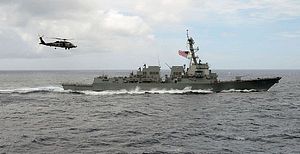For the second time since June, a U.S. Navy guided-missile destroyer conducted a freedom of navigation operation (FONOP) in the Caribbean Sea off the coast of Venezuela last Wednesday. For the first time in three decades, U.S. warships in May conducted FONOPs in the Barents Sea near Russia’s northern coast. And with increasing regularity, U.S. Navy warships press the envelope of challenging Chinese maritime claims with FONOPs as close as 12 nautical miles from Chinese-claimed territory.
Before a mistake or miscalculation results in an armed clash involving a U.S. naval vessel – which could draw the United States into a serious conflict – we need to examine the utility of aggressive FONOPs.
The ultimate purpose for any military operation away from U.S. shores ought to be the security and prosperity of the country. Any operation or action contributing to that objective should be given serious consideration, but anything that has an unacceptable chance of harming U.S. interests should be rejected. FONOPs, as currently practiced, are increasing the chances the United States will one day stumble into a war.
Given the expansion in the number of FONOPs against China, the increase in such operations targeting Russia, and the now-expanding operations into South America, the assumption would be that multiple navies are threatening U.S. freedom on the seas. Nothing could be further from the truth.
Civilian maritime traffic worldwide is shared online to give a real-time update of where global trade is taking place on the seas. You don’t have to be an expert to look at the live map at any time to see that there are no gaps near Russia, China, or Venezuela that would signal the need for a muscular American naval response. No one is threatening to block traffic.
To the contrary, China and Russia especially are highly dependent on international trade and need sea traffic to continue unimpeded; they would be the first to lose should either engage in shutting down traffic on the seas.
Like any military organization, it is a necessity to exercise the U.S. Navy to maintain proficiency in its core warfighting skills. They need to be ready, on a moment’s notice, to defend the United States’ global interests, to repulse any attack, and to viciously punish any who dare strike us. This level of proficiency allows the U.S. to effectively deter any attack but also provides the muscle to defeat any opponent if deterrence fails.
To maintain this level of deterrence and war-winning capacity, the U.S. Navy needs to conduct regular, prudent global patrols and exercises to maintain warfighting proficiency. Doing so will ensure security and economic freedom for U.S. companies and business interests without unnecessarily provoking adversaries to take action against our interests.
One doesn’t have to be an apologist for any foreign power to recognize that continual patrols with powerful warships close to their shores is going to precipitate a response. If the Chinese navy were to challenge U.S. supremacy in the Pacific and Atlantic oceans by building naval bases near the U.S. coast and regularly sailing within 12 miles of U.S. shores, Washington would not passively acknowledge their rights of transiting international waters.
Perhaps more critically, Washington should encourage friendly regional states and allies to enhance their own security via anti-access, area denial (A2/AD) self-defense capabilities. China has become an expert at A2/AD technologies and has made any attack on its territory or forces to be an expensive and deadly prospect.
The best way the United States can accomplish its objectives in the Asia-Pacific region is to encourage allies and other friendly states to invest much more heavily in their own A2/AD capabilities that would deter China from attempting to take any of them by military force. Doing so places the responsibility for self-defense more heavily on each country – where it belongs – and less on asking the U.S. Navy and Air Force to underwrite regional security for states that can afford to invest more in their own defense needs.
FONOPs have a place in America’s tool chest, but only if used sparingly and wisely. Relying too heavily on such operations disincentivizes allied and friendly countries from investing in their own defense, placing an unnecessary burden on U.S. forces – and increases the risk the United States may one day be sucked into a war it should never have fought.
Daniel L. Davis is a Senior Fellow for Defense Priorities and a former Lt. Col. in the U.S. Army who retired in 2015 after 21 years, including four combat deployments. Follow him @DanielLDavis1.

































